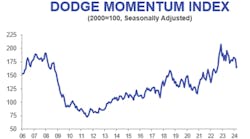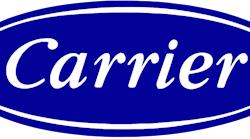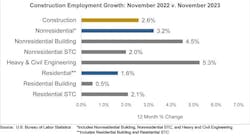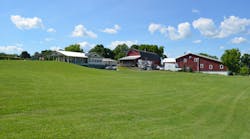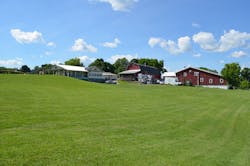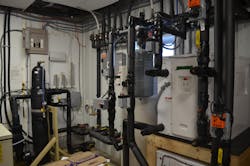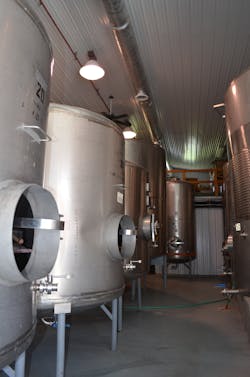Known for the first genuine ice wine produced in the United States and made broadly available, Hunt Country Vineyards, located on a 170-acre farm in the Finger Lakes region of New York, is no stranger to accolades. But wines are not all for which the vintner has been recognized. In 2015, Hunt Country Vineyards, along with Penn Yan, N.Y.-based Moravec Geothermal, received the New York Geothermal Energy Organization’s Top Job award for its geothermal heating and cooling system.
Installed in 2012, the system supports the sustainability goals that are so important to the Hunt family.
“It’s all part of trying to optimize our environment for long-term sustainability,” Art Hunt, co-founder and co-owner of the winery, said.
Previously, Hunt Country Vineyards relied on a combination of propane, fuel oil, and electricity to heat and cool the wine-making operation. In 2011, Hunt approached Kevin Moravec, owner of Moravec Geothermal, about installing a geothermal system. It was not until 2012 that all of the pieces, including a $102,000 grant from the New York State Energy Research and Development Authority, fell into place.
Critical to the success of the project was Auburn, N.Y.-based Phoenix Energy Supply, which provided piping materials, pumps, and valves. Under the direction of President John Manning, Phoenix Energy Supply also helped with design of the system, layout of the loop field, and subassembly, while Moravec Geothermal coordinated the installation of the loop field and the equipment anchoring the system.
Eight Boreholes Feeding Into 20-Ton Vertical Closed Loop
The loop field is a 20-ton vertical closed loop comprised of eight 375-ft-deep boreholes.
“Although it’s commonly understood that laying a horizontal loop field is typically less costly than drilling boreholes for a vertical loop, in this case, we would have needed the better part of an acre to put in a loop field large enough to meet our needs,” Hunt said. “The boreholes only required a 20-by-40-ft piece of property. The 750 ft of piping that goes down and back up each bore amounts to a loop that contains approximately 6,000 ft of piping.”
All of this piping comes together in a single manifold that feeds into the tasting-room building. From there, it is distributed to two 4-ton and four 3-ton GeoStar Aston geothermal heat pumps and three GeoStar air handlers that provide heating and cooling to the tasting-room building, the production building, and the storage facility.
Aston heat pumps use environmentally safe R-410A refrigerant and include dual-capacity Copeland Scroll compressors to provide heating, cooling, and hot-water assist in a single unit. Dual capacity means the compressors can run at two speeds, based on the needs of the system. So, instead of the bursts of air that allow a normal furnace to “catch up,” Aston keeps temperature and airflow regulated at a steadier, quieter rate for improved comfort and efficient operation. The units feature Aurora controls, which provide two-way communication between components, a modular design for future upgrades, and easy-to-use diagnostic and monitoring capabilities.
“Historically, you might install a geo loop field for each of the buildings and bring each field to a heat pump that serves the building,” Manning explained. “What you lose when you do that is the benefit of having a large consolidated loop field that can mix all the different thermal loads of the buildings. So, one building may need air conditioning while another needs process heat. The design at Hunt Country Vineyards is like a mini energy node that allows heat or cooling to be moved around and shared from a consolidated loop.”
Two-Stage Cooling Provides Even, Efficient Cooling
According to Moravec, the six GeoStar heat pumps are stacked in pairs, creating two stages of operation for each of the three buildings.
“We did this instead of installing three much larger units, whose full load would not be required most of the time,” Moravec said. “This design provides maximum conservation of energy. The more heat pumps that need heating or cooling, the faster the pumping system works.
“I wouldn’t say this system is unusual or unique,” Moravec continued. “But I would say that it’s rarely used because of the complexity of controlling flow across about an acre of property. That’s really the biggest challenge—that and the fact that, in this case, we were retrofitting a 100-year-old farm and weren’t sure what we were going to find as the work began. But once we got inside the buildings, there wasn’t much that separated what happens there from what happens in a typical residential setup.”
Manning added: “I think, in general, the practice of geothermal is a bit of an art. It’s not plug-and-play, and it’s not cookie-cutter. You really have to pay attention to details and do your calculations carefully. Just as important, you must listen and gain an understanding of the wants and needs of each customer because geothermal can address a variety of needs beyond heating and cooling.”
Geothermal Heating and the Fermentation Process
Hunt Country Vineyards harvests its red grapes late in the growing season to ensure maximum ripeness. That may mean leaving grapes on the vine until temperatures drop to 40°F.
“If you think about putting 10 tons of 40-degree grapes in a tank, that’s a huge thermal mass,” Hunt said. “They won’t ferment until the temperature in the tank rises above 60 degrees, preferably in the 70-to-80-degree range. So, we heat the grapes by running the warm glycol mixture supplied by heat pumps through jackets on the outside of the tanks. Once the temperature in the tank rises to 60 degrees, the yeast begins to ferment, producing additional heat to warm the grapes.”
The tanks are heated a second time to warm wine that has been cold-stabilized to remove tartrate crystals and create a smoother wine.
“If you run ice-cold wine into a bottling line, you’ll get condensation on the outside of the bottle, and the labels won’t stick,” Hunt said. “So, we pump the wine into a clean tank and warm it.”
Moravec added: “This demonstrates that systems like this work in all different types of applications. There’s not a situation out there that we can’t address with geothermal.”
Energy Savings
In the case of Hunt Country Vineyards, the geothermal system saves approximately $10,000 to $12,500 in propane/fuel-oil/electricity costs annually, while providing increased comfort during summer and winter.
Hunt Country Vineyards recently installed 348 photovoltaic solar panels on the roofs of the winery, workshop, and tasting room. Hunt estimates the solar panels will supply 70 to 75 percent of the winery’s electricity needs.
“We’re also replacing traditional light bulbs with LED lights,” Hunt said, “and at some point in the future, we’d like to replace our chillers, using the geothermal system to chill our wines.”
Such measures are about more than saving money and increasing profits.
“As we conserve energy with geothermal systems and solar panels and improve the land we farm, we’re really investing in our future—the seventh generation of Hunts already running around the property—so that one day, they, too, can enjoy this land and the lifestyle it supports,” Hunt said.
For Design Solutions author guidelines, call Scott Arnold, executive editor, at 216-931-9980, or write to him at [email protected].
